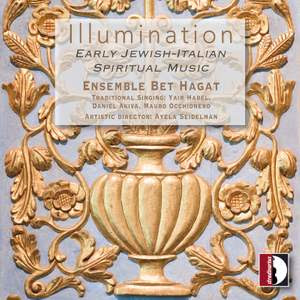Program: #20-49 Air Date: Nov 23, 2020
To listen to this show, you must first LOG IN. If you have already logged in, but you are still seeing this message, please SUBSCRIBE or UPGRADE your subscriber level today.
Sacred works by Frescobaldi, Marian hymns by Caccini and others, and Jewish-Italian spiritual music.
I. Girolamo Frescobaldi: Organ Works & Motets (La Divina Armonia/Lorenzo Ghielmi). Passacaille CD 1044.
:format(jpeg):mode_rgb():quality(40)/discogs-images/R-13914345-1563962004-8904.jpeg.jpg)
| 1 | Jesu Rex Admirabilis, F 11.23 | 2:38 |
| 2 | Ave Virgo Gloriosa, F 11.31 | 3:26 |
| 3 | O Jesu Mi Dulcissime, F 11.05 | 2:44 |
| 4 | Capriccio Sopra La Bassa Fiamenga F 4.05 | 5:33 |
| 5 | Toccata Terza Per Sonarsi Alla Levatione, F 3.03 | 6:40 |
| 6 | Gagliarda Seconda, F 3.28 | 0:56 |
| 7 | Gagliarda Terza, F 3. | 1:36 |
| 8 | Peccavi Super Numerum F 11.40 | 2:38 |
| 9 | Tota Pulchra Es Amica Mea, F 11.15 | 2:25 |
| 10 | Toccata Avanti La Messa Della Madonna , F 12.34 | 1:04 |
| 11 | Canzon Dopo L'Epistola, F 12.14 | 2:56 |
| 12 | Toccata Per L'Elevazione, F 12.45 | 2:53 |
| 13 | Ego Sum Qui Sum, F 11.28 | 2:02 |
| 14 | De Ore Prudentis Procedit Mel, F 11.7 | 2:20 |
| 15 | Aria Detto Balletto, F 3.26 | 7:57 |
| 16 | Canzon Quarta, F 3.16 | 3:48 |
| 17 | Vox Dilecti Mei Pulsantis, F 11.21.01: Prima Pars | 1:49 |
| 18 | Quam Pulchra Es, F11.21.02: Seconda Pars | 2:01 |
| 19 | Aria Detta La Frescobalda, F3.32 | 3:51 |
| 20 | Toccata Seconda, F 3.02 | 3:53 |
| 21 | Fantasia Prima, F 6.01 | 3:45 |
| 22 | Toccata Quarta Per Sonarsi Alla Levatione, F 3.04 | 5:21 |
| 23 | Toccata Con Il Contrabbasso Ovvero Pedale, F 15.11 | 1:59 |
II. Maria, Dolce Maria Brilliant Classics CD 95893

As a central member of the vocal consort Le nuove musiche directed by Krijn Koetsveld, the harpsichordist on this album, Wendy Roobol has performed the complete madrigals of Monteverdi in critically acclaimed recordings for Brilliant Classics.
Her first solo album draws on that expertise to present a unique programme of Marian hymns from around Europe. The great names of the Italian school are naturally represented, opening with the title-song by Francesca Caccini (talented daughter of Giulio Caccini) and reaching a fitting climax with Salve, O Regina by Monteverdi and the Lament of the Madonna from his Selva morale e spirituale collection.
In between those unchallenged masterpieces of the late Renaissance, Wendy Roobol ventures across Europe, first to Switzerland, for a sensuous Ave Maria by Johann Melchior Gletle, then to mid-Germany for a Magnificat by Philipp Friedrich Böddecker. These marvellous but little-known pieces have been recorded before, but not in their originally intended format of solo soprano with consort accompaniment, and these performances are graced by intense sensitivity and a spirit of intimacy that captures the devotional atmosphere of a Marian chapel.
Giovanni Felice Sances is another little-known composer represented here, but whose 1636 Stabat mater is touched by rich and affective dissonance. It makes a fine complement to the plainer declamation of the Sancta mater by the German-Italian lutenist Girolamo Kapsberger.
III. Illumination: Early Jewish-Italian Spiritual Music (Ensemble Bet Hagat/Ayela Seidelman). Stradivarius CD STR 37124.

| 1 | Prologue: Shir La-Ma'alo, Composed By – Salomone Rossi | |
| 2 | Adon Ha-Slichot | |
| 3 | Achot Ketana | |
| 4 | Chi Sapeva (Ehad Mi Yodea) | |
| 5 | Yehi Shalom Be-Helenu | |
| 6 | Maoz Tzur | |
| 7 | Hallel | |
| 8 | Betzet Yisrael | |
| 9 | Sha'ar Asher Nisgar (O Immacolata E Pura) | |
| 10 | Kiddush | |
| 11 | Chad Gadya | |
| 12 | Chad Gadya / Alla Fiera Dell'Est | |
| 13 | Epilogue: Keter, Composed By – Salomone Rossi |
Composer Info
Girolamo Frescobaldi (1583-1643), Francesca Caccini, Johann Melchior Gletle, Girolamo Frescobaldi, Tarquinio Merula, Giovanni Girolamo Kapsberger, Tarquinio Merula, Philipp Friedrich Boddecker, Giovanni Felice Sances, Claudio Monteverdi, Salomone Rossi (c. 1570-1630),
CD Info
Passacaille CD 1044, Brilliant Classics CD 95893, Stradivarius CD STR 37124.